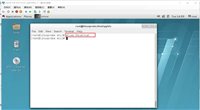nmap是一款针对大型网络的端口扫描工具,被广泛应用于黑客领域做漏洞探测以及安全扫描,其主要功能有主机发现(host discovery)、 端口扫描(port scanning)、 版本侦测(version detection) 、操作系统侦测(operating system detection),可以适用于winodws,linux,mac等操作系统。
1、yum安装nmap
yum install nmap

nmap 命令参数:nmap -h
[root@lamp01 scripts]# nmap -h
nmap 5.51 ( http://nmap.org )
usage: nmap [scan type(s)] [options] {target specification}
target specification:
can pass hostnames, ip addresses, networks, etc.
ex: scanme.nmap.org, microsoft.com/24, 192.168.0.1; 10.0.0-255.1-254
-il <inputfilename>: input from list of hosts/networks
-ir <num hosts>: choose random targets
--exclude <host1[,host2][,host3],...>: exclude hosts/networks
--excludefile <exclude_file>: exclude list from file
host discovery:
-sl: list scan - simply list targets to scan
-sn: ping scan - disable port scan
-pn: treat all hosts as online -- skip host discovery
-ps/pa/pu/py[portlist]: tcp syn/ack, udp or sctp discovery to given ports
-pe/pp/pm: icmp echo, timestamp, and netmask request discovery probes
-po[protocol list]: ip protocol ping
-pr: arp ping - does not need hw address -> ip translation
-n/-r: never do dns resolution/always resolve [default: sometimes]
--dns-servers <serv1[,serv2],...>: specify custom dns servers
--system-dns: use os's dns resolver
--traceroute: trace hop path to each host
scan techniques:
-ss/st/sa/sw/sm: tcp syn/connect()/ack/window/maimon scans
-su: udp scan
-sn/sf/sx: tcp null, fin, and xmas scans
--scanflags <flags>: customize tcp scan flags
-si <zombie host[:probeport]>: idle scan
-sy/sz: sctp init/cookie-echo scans
-so: ip protocol scan
-b <ftp relay host>: ftp bounce scan
port specification and scan order:
-p <port ranges>: only scan specified ports
ex: -p22; -p1-65535; -p u:53,111,137,t:21-25,80,139,8080,s:9
-f: fast mode - scan fewer ports than the default scan
-r: scan ports consecutively - don't randomize
--top-ports <number>: scan <number> most common ports
--port-ratio <ratio>: scan ports more common than <ratio>
service/version detection:
-sv: probe open ports to determine service/version info
-sr: check what service uses opened ports using rpc scan
--version-intensity <level>: set from 0 (light) to 9 (try all probes)
--version-light: limit to most likely probes (intensity 2)
--version-all: try every single probe (intensity 9)
--version-trace: show detailed version scan activity (for debugging)
script scan:
-sc: equivalent to --script=default
--script=<lua scripts>: <lua scripts> is a comma separated list of
directories, script-files or script-categories
--script-args=<n1=v1,[n2=v2,...]>: provide arguments to scripts
--script-trace: show all data sent and received
--script-updatedb: update the script database.
os detection:
-o: enable os detection
--osscan-limit: limit os detection to promising targets
--osscan-guess: guess os more aggressively
timing and performance:
options which take <time> are in seconds, or append 'ms' (milliseconds),
's' (seconds), 'm' (minutes), or 'h' (hours) to the value (e.g. 30m).
-t<0-5>: set timing template (higher is faster)
--min-hostgroup/max-hostgroup <size>: parallel host scan group sizes
--min-parallelism/max-parallelism <numprobes>: probe parallelization
--min-rtt-timeout/max-rtt-timeout/initial-rtt-timeout <time>: specifies
probe round trip time.
--max-retries <tries>: caps number of port scan probe retransmissions.
--host-timeout <time>: give up on target after this long
--scan-delay/--max-scan-delay <time>: adjust delay between probes
--min-rate <number>: send packets no slower than <number> per second
--max-rate <number>: send packets no faster than <number> per second
firewall/ids evasion and spoofing:
-f; --mtu <val>: fragment packets (optionally w/given mtu)
-d <decoy1,decoy2[,me],...>: cloak a scan with decoys
-s <ip_address>: spoof source address
-e <iface>: use specified interface
-g/--source-port <portnum>: use given port number
--data-length <num>: append random data to sent packets
--ip-options <options>: send packets with specified ip options
--ttl <val>: set ip time-to-live field
--spoof-mac <mac address/prefix/vendor name>: spoof your mac address
--badsum: send packets with a bogus tcp/udp/sctp checksum
output:
-on/-ox/-os/-og <file>: output scan in normal, xml, s|<ript kiddi3,
and grepable format, respectively, to the given filename.
-oa <basename>: output in the three major formats at once
-v: increase verbosity level (use -vv or more for greater effect)
-d: increase debugging level (use -dd or more for greater effect)
--reason: display the reason a port is in a particular state
--open: only show open (or possibly open) ports
--packet-trace: show all packets sent and received
--iflist: print host interfaces and routes (for debugging)
--log-errors: log errors/warnings to the normal-format output file
--append-output: append to rather than clobber specified output files
--resume <filename>: resume an aborted scan
--stylesheet <path/url>: xsl stylesheet to transform xml output to html
--webxml: reference stylesheet from nmap.org for more portable xml
--no-stylesheet: prevent associating of xsl stylesheet w/xml output
misc:
-6: enable ipv6 scanning
-a: enable os detection, version detection, script scanning, and traceroute
--datadir <dirname>: specify custom nmap data file location
--send-eth/--send-ip: send using raw ethernet frames or ip packets
--privileged: assume that the user is fully privileged
--unprivileged: assume the user lacks raw socket privileges
-v: print version number
-h: print this help summary page.
examples:
nmap -v -a scanme.nmap.org
nmap -v -sn 192.168.0.0/16 10.0.0.0/8
nmap -v -ir 10000 -pn -p 80
see the man page (http://nmap.org/book/man.html) for more options and examples
2、nmap 常用命令介绍:
扫描单个主机:
nmap 192.168.43.118
扫描单个子网主机:
nmap 192.168.43.0/24
扫描多个主机:
nmap 192.168.43.117 192.168.43.43.99
扫描一个范围内的主机:
nmap 192.168.43.1-254
若你有一个ip地址表,将ip地址存在ip.log文件中,命令如下:
nmap -il ip.log
若你想查看扫描的所有主机列表命令如下:
nmap -sl 192.168.43.1/24
扫描一子网主机且排除某一个ip命令:
nmap 192.168.43.1/24 -exclude 192.168.43.118
扫描一子网主机且排除某一个ip地址表命令:
nmap 192.168.43.1/24 -exclude ip.log
扫描主机路由跟踪信息:
nmap --traceroute 192.168.43.118
扫描主机信息结果详细输出:
nmap -vv --traceroute 192.168.43.118
扫描某主机上指定的端口或协议,例如80,21,22
nmap -p u:53,t:80,21,22,s:9 192.168.43.118 (其中t代表tcp协议、u代表udp协议、s代表sctp协议)

快速扫描端口模式,扫描100个最有可能开放的端口 -v 获取扫描的信息
nmap -f -v 192.168.43.118

tcp syn scan (ss) 隐蔽扫描
这是一个不完整的扫描方式,它被称为半开放扫描,nmap发送syn包到远程主机,但是它不会产生任何会话,在syn扫描中不需要通过完整3次的握手,因此不会在目标主机上产生任何日志记录,这个就是syn扫描的优势,但是这种扫描是需要root权限(对于windows用户来说,是没有root权限这个概念的,root权限是linux的最高权限,对应windows的管理员权限)
nmap -ss 192.168.43.118

tcp connect() scan(st) 最常用
如果不选择syn扫描,tcp connect()扫描就是默认的扫描模式,不同于tcp syn扫描,tcp connect()扫描需要完成三次握手,并且要求调用系统的connect(),tcp connect()扫描技术只适用于找出tcp和udp端口,但是这种方式扫描的速度快,准确性高,对操作者没有权限上的要求,但是容易被防火墙和ids(防入侵系统)发现。
nmap -st 192.168.43.118

udp scan(su)
顾名思义,这种扫描技术用来寻找目标主机打开的udp端口,它不需要发送任何的syn包,因为这种技术是针对udp端口的。udp扫描发送udp数据包到目标主机,并等待响应,如果返回icmp不可达的错误消息,说明端口是关闭的,如果得到正确的适当的回应,说明端口是开放的。
nmap -su 192.168.43.118
fin scan (sf)
有时候tcp syn扫描不是最佳的扫描模式,因为有防火墙的存在,目标主机有时候可能有ids和ips系统的存在,防火墙会阻止掉syn数据包。发送一个设置了fin标志的数据包并不需要完成tcp的握手,收到rst回复说明该端口关闭,否则说明是open或filtered状态
nmap -sf 192.168.43.118
ping scan (sp) 扫描在线主机
ping扫描它只用于找出主机是否是存在在网络中的,它不是用来发现是否开放端口的,ping扫描需要root权限,如果用户没有root权限,ping扫描将会使用connect()调用。
nmap -sp 192.168.43.118
版本检测(sv)
版本检测是用来扫描目标主机和端口上运行的软件的版本,它不同于其它的扫描技术,它不是用来扫描目标主机上开放的端口,不过它需要从开放的端口获取信息来判断软件的版本,使用版本检测扫描之前需要先用tcp syn扫描开放了哪些端口。
nmap -sv 192.168.43.118
idle scan (sl)
idle scan是一种先进的匿名扫描技术,它不是用你真实的主机ip发送数据包,而是使用另外一个目标网络的主机发送数据包,例如:通过目标网络中的192.168.43.118向主机192.168.43.4发送数据,来获取192.168.1.1开放的端口。
nmap -sl 192.168.43.118 192.168.43.4
有需要其它的扫描技术,如 ftp bounce(ftp反弹), fragmentation scan(碎片扫描),ip protocol scan(ip协议扫描),以上讨论的是几种最主要的扫描方式。
nmap的os检测(o)
nmap最重要的特点之一是能够远程检测操作系统,nmap的os检测技术在渗透测试中用来了解远程主机的操作系统是非常有用的,通过获取的信息你可以知道已知的漏洞
nmap -o 192.168.43.17

ack扫描:
利用ack扫描判断端口是否被过滤。针对ack探测包,为被过滤的端口(无论打开或关闭)会回复rst包
nmap -sa -t4 p1521,80 192.168.43.17
使用tcp ack (pa)和tcp syn (ps)扫描远程主机
nmap -pa -t4 p1521,80 192.168.43.17
nmap -pa -t4 p1521,80 192.168.43.17
扫描前不进行ping扫描测试:
nmap -pn p1521,80 192.168.43.17
通过tcp空扫描以绕过防火墙检测:
nmap -sn 192.168.43.17

打印主机接口和路由
nmap --iflist
按顺序扫描端口:
nmap -r 192.168.43.118
扫描主机检测是否有防火墙过滤:
nmap -pn -p 1521 192.168.43.17

扫描操作系统信息和路由跟踪
使用nmap,你可以检测远程主机上运行的操作系统和版本。为了启用操作系统和版本检测,脚本扫描和路由跟踪功能,我们可以使用nmap的“-a“选项。
nmap -a 192.168.43.17

扫描端口时状态介绍:
open 端口开启,数据有到达主机,有程序在端口上监控
closed 端口关闭,数据有到达主机,没有程序在端口上监控
filtered 数据没有到达主机,返回的结果为空,数据被防火墙或者是ids过滤
unfiltered 数据有到达主机,但是不能识别端口的当前状态
open|filtered 端口没有返回值,主要发生在udp、ip、fin、null和xmas扫描中
closed|filtered 只发生在ip id idle扫描
以上总结来源于网络。
如您对本文有疑问或者有任何想说的,请点击进行留言回复,万千网友为您解惑!














网友评论